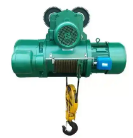Electric hoists are mainly divided into two categories based on the differences in traction devices: loop chain electric hoists and wire rope electric hoists. This time, we will focus on the wire rope electric hoist and deeply analyze its core structure - the unique characteristics of the wire rope core structure.
In wire rope electric hoists, the core material is mainly divided into two categories. One type is the rope core made of soft steel wire, which can work stably under lateral pressure and high temperature environment due to its high strength characteristics. However, its toughness is relatively weak, and attention should be paid to adapting to the working conditions when using it. Another type is asbestos core rope core, which is made of asbestos fibers as raw materials and fully soaked with anti-corrosion and anti rust lubricating oil. With this special structure, the rope core can operate continuously in high temperature environments, demonstrating excellent heat resistance.

The breaking force of a steel wire rope, as a key indicator to measure its performance, not only represents the maximum load that the steel wire rope can withstand, but also the total breaking force of each constituent steel wire. Among the many factors that affect the breaking force of steel wire ropes, the strength of the rope core plays a crucial role, directly determining the overall load-bearing capacity of the steel wire rope.
With the continuous development of the industrial field, wire rope electric hoists have been widely used due to their reliable performance. It is worth noting that the rated load of an electric hoist is not solely determined by the equipment itself, and the strength of the steel wire rope plays a decisive role in the entire load system. It is not only related to the normal operation of equipment, but also closely linked to job safety.